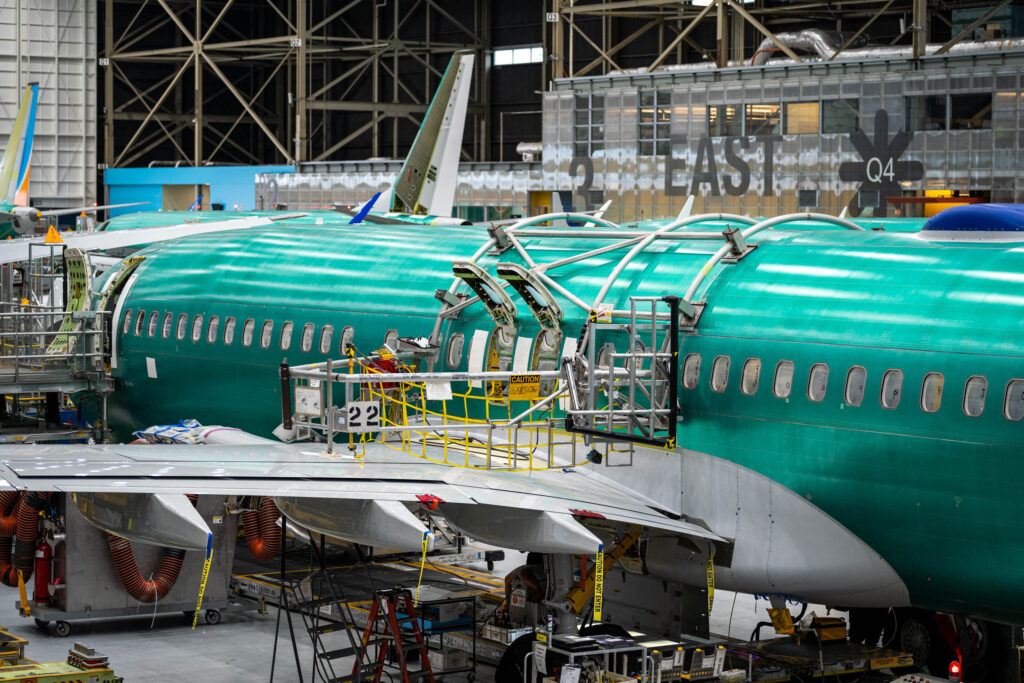Several U.S. airlines said Tuesday that they were reducing growth targets for 2024 and even adjusting their long-term plans because of the ongoing crisis at Boeing.
In a scene reminiscent of 2019, when the global grounding of the 737 MAX fleet limited deliveries for nearly two years — and left several carriers with scores of planes parked in storage — several carriers said that the latest episode stemming from an incident with Boeing’s MAX had impacted their plans for at least the coming year, likely longer.
The comments came during an industry conference hosted by JP Morgan.
Want more aviation news? Sign up for TPG’s free biweekly Aviation newsletter.
Southwest no longer expects Boeing’s smallest and longest-range version of the narrow-body workhorse, the 737 MAX 7, to be delivered this year, CEO Bob Jordan said, and the airline expects to receive 46 of the MAX 8 model this year, down from an earlier forecast of 58.
Including the MAX 7, the airline had originally expected to receive 79 new airplanes this year. Southwest plans to reduce its capacity for the year and will cut most hiring, including pilots and flight attendants, due to the lower forecasted aircraft deliveries.
Alaska Airlines said that its capacity plans are “in flux” due to shifting timelines around deliveries.
United Airlines CEO Scott Kirby, meanwhile, said that the airline had instructed Boeing to stop building 737 MAX 10 jets for the carrier until it becomes clearer “if and when” the airplane will be certified. The airline has asked Boeing to instead produce the smaller, but already certified, 737 MAX 9 during those manufacturing slots.
DAVID SLOTNICK/THE POINTS GUY
The smallest MAX 7 and largest MAX 10 variants have not yet been certified by the FAA, while the midsized MAX 8 and MAX 9 operate for airlines around the globe. Certification on the newer models has been progressively delayed as Boeing works to satisfy numerous safety requirements, including some implemented in the aftermath of the two fatal MAX crashes in 2018 and 2019 that killed 346 people and led to the grounding.
Related: What to know about the Boeing 737 MAX 9 and the MAX series
CEO Robert Isom of American Airlines, which operates the 737 MAX 8, said that the airline does not expect to begin adding the 737 MAX 10s announced as part of a recent order to its fleet plans until 2028, and does not expect any relevant delays even though the airline says that it has negotiated contingencies to switch its order to a different MAX variant if there are further delays
Delta Air Lines, which announced an order for the MAX 10 during 2022’s Farnborough Air Show but does not fly either of the current MAX models, did not suggest any cuts to its capacity.
The Boeing crisis stems from a Jan. 5 incident on board an Alaska Airlines flight. As the airline’s 737 MAX 9 departed from Oregon’s Portland International Airport (PDX) and climbed through about 16,000 feet, a door plug broke free from the body of the jet and caused the cabin to rapidly decompress. The flight returned to Portland without serious injuries to anyone on board.
The initial investigation preliminarily found that the door plug was missing four crucial bolts that secure it to the aircraft fuselage, while subsequent investigations have found problems with Boeing’s manufacturing practices. The planemaker failed 33 out of 89 audits of its quality control procedures carried out by the Federal Aviation Administration in the weeks following the Alaska Airlines incident.
DAVID SLOTNICK/THE POINTS GUY
While Boeing had planned to increase its 737 production rate from its current goal of 38 aircraft per month, which it has not met in recent months, the FAA has prohibited it from increasing that rate until various safety concerns are addressed.
In a memo to employees on Tuesday seen by TPG, Stan Deal, head of Boeing’s commercial aircraft division, said that the company was making progress on improving its safety practices while acknowledging that there is still work remaining.
“The vast majority of our audit non-compliances involved not following our approved processes and procedures,” Deal said, noting that the assembly line would add additional compliance checks and various audits.
Boeing Commercial CEO Stan Deal tells employees in a memo that “The vast majority of our [FAA] audit non-compliances involved not following our approved processes and procedures.” pic.twitter.com/khfWanZav8
— David Slotnick (@David_Slotnick) March 12, 2024
Boeing CEO Dave Calhoun has said that the planemaker accepts responsibility for the faults and vowed to fix the company’s production lines, even as the company has come under fire for missing documentation or failing to provide timely information to investigators.
Even so, while noting their frustrations with Boeing, airline CEOs on Tuesday expressed optimism and a degree of confidence in the company.
“I am encouraged with Boeing, I think they have accepted that there are larger changes they need to make,” Kirby of United said. “This is not a 12-month issue. This is a two-decade issue. And I’d rather Boeing do what they need to do, and I think they are now.”
“I’m encouraged at least at the first step. It’s a long journey, it’s one step, but I’m encouraged at that important step,” he added.
Kirby noted that the airline would pivot and purchase the competitive Airbus A321 instead, if an opportunity becomes available.
Bob Jordan, the Southwest CEO, said that he believed that Boeing was “embracing” the work needed to course-correct.
“Stop, take the time, understand what’s going on, fix the culture,” Jordan said. “We all need Boeing to be stronger two years from now, five years from now, 10 years from now.”
“Boeing needs to become a better company,” he added.
